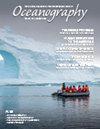Integrating Biodiversity and Environmental Observations in Support of National Marine Sanctuary and Large Marine Ecosystem Assessments
IF 2.8
4区 地球科学
Q1 OCEANOGRAPHY
引用次数: 2
Abstract
Species and habitats are the subjects of legislation that mandates reporting of information on ecosystem conditions. Improvements in sensors, sampling platforms, information systems, and collaborations among experts and information users now enables more effective and up-to-date information to meet regional and national needs. Specifically, advances in environmental DNA (eDNA)-based assessments of biodiversity, community science data, various underwater imaging devices, and environmental, behavioral, and physiology observations from animal telemetry provide new opportunities to address multiple requirements for reporting status and trends, including insights into life in the deep ocean. Passive and active acoustic sensors help monitor marine life, boat traffic, and noise pollution. Satellites provide repeated, frequent, and long-term records of many relevant variables from global to local scales and, when combined with numerical computer simulations, allow planning for future scenarios. Metadata standards facilitate the transfer of data from machine to machine, thus streamlining assessments and forecasting and providing knowledge directly to the public. The Marine Biodiversity Observation Network (MBON) facilitates this exchange of information on life in the sea. The collaborative efforts of the Central and Northern California Ocean Observing System (CeNCOOS) of the US Integrated Ocean Observing System and its partners provide an example of a regional MBON process for information delivery. This includes linking policy and management needs, prioritizing observing data from various platforms and methods, streamlining data handling practices, and delivery of information for management such as for the Monterey Bay National Marine Sanctuary and the California Current Large Marine Ecosystem, with iterative process adaptation.整合生物多样性和环境观测支持国家海洋保护区和大型海洋生态系统评估
物种和栖息地是要求报告生态系统状况信息的立法的主题。传感器、采样平台、信息系统以及专家和信息用户之间的合作的改进,使更有效和最新的信息能够满足区域和国家的需求。具体而言,基于环境DNA(eDNA)的生物多样性评估、社区科学数据、各种水下成像设备以及动物遥测的环境、行为和生理观测的进展为满足报告状态和趋势的多种要求提供了新的机会,包括对深海生命的深入了解。无源和有源声学传感器有助于监测海洋生物、船只交通和噪音污染。卫星提供了从全球到地方范围内许多相关变量的重复、频繁和长期记录,当与数字计算机模拟相结合时,可以规划未来的情景。元数据标准有助于将数据从一台机器转移到另一台机器,从而简化评估和预测,并直接向公众提供知识。海洋生物多样性观测网促进了海洋生物信息的交流。美国综合海洋观测系统的中加利福尼亚和北加利福尼亚海洋观测系统及其合作伙伴的合作努力提供了一个区域MBON信息传递过程的例子。这包括将政策和管理需求联系起来,优先考虑来自各种平台和方法的观测数据,简化数据处理实践,以及为管理提供信息,如蒙特利湾国家海洋保护区和加州当前大型海洋生态系统,并进行迭代过程调整。
本文章由计算机程序翻译,如有差异,请以英文原文为准。
求助全文
约1分钟内获得全文
求助全文
来源期刊

Oceanography
地学-海洋学
CiteScore
6.10
自引率
3.60%
发文量
39
审稿时长
6-12 weeks
期刊介绍:
First published in July 1988, Oceanography is the official magazine of The Oceanography Society. It contains peer-reviewed articles that chronicle all aspects of ocean science and its applications. In addition, Oceanography solicits and publishes news and information, meeting reports, hands-on laboratory exercises, career profiles, book reviews, and shorter, editor-reviewed articles that address public policy and education and how they are affected by science and technology. We encourage submission of short papers to the Breaking Waves section that describe novel approaches to multidisciplinary problems in ocean science.
 求助内容:
求助内容: 应助结果提醒方式:
应助结果提醒方式:


